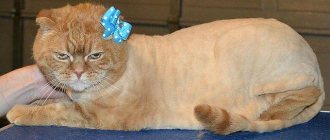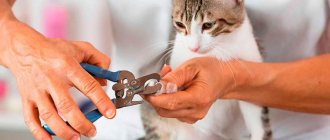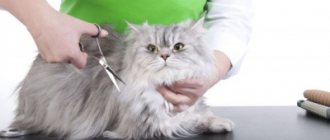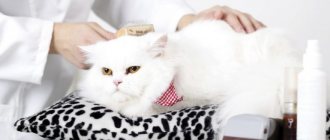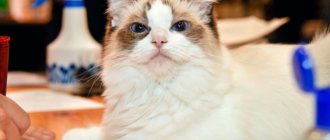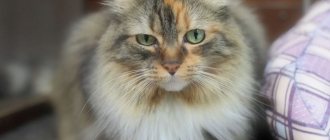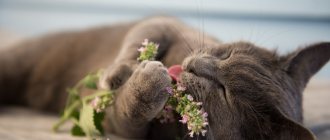Furry pet lovers often wonder: is it possible to groom cats? The answer is clear - yes, it is possible, sometimes even necessary! Grooming cats and cats is becoming increasingly popular. The reasons are dictated by the need to provide complete care for your pet’s fur coat. And if you get creative, the animal takes on an interesting image.
Is it true that cats can be cut?
For cats that live in the private sector and spend a lot of time outdoors, careful care is essential. After a walk, your pet may return not only with dirty hair, but also with hair matted into lumps. In this case, scissors will come to your aid. And if your pet has long, thick hair, then to avoid such troubles it makes sense to get a beautiful haircut with the onset of the warm season. If your cat is domestic, and you have enough time, effort and patience to take care of your pet’s fur every day and keep it clean and tidy, you can avoid going to the “cat” hairdresser - groomer. Even if there is no need to cut your pet’s hair, it is advisable to use a fuminator or slicker; they comb out the dead undercoat without touching the living one.
How to trim or shave your pet if necessary?
Hairdressing procedures at home are carried out according to a certain algorithm:
- Trimming nails. It is carried out with special tweezers, pre-disinfected. Light pressure on the paw pads causes the hidden claws to extend; the owner only needs to trim the very tips. This procedure will prevent scratches during cutting.
- When performing the initial manipulation, an assistant is needed - he must hold the animal, preventing it from running away. Some cats become aggressive when they see grooming tools. For safety, the pet is wearing a plastic collar that prevents it from biting.
- The cat is laid on its side, its paws are securely fixed. For cutting, use a clipper or scissors. The first will avoid damage to the skin, but can irritate and frighten the pet with its buzzing.
- The fur is removed from the sides, then moved to the back and belly. Hair removal is carried out both in the direction of its growth and in the opposite direction. The remaining long hairs are trimmed with nail scissors. There must be a tassel on the tail.
After the procedure is completed, the pet is bathed with a special cat shampoo and dried with a towel. If the animal is not afraid of a hair dryer, then it is also used for drying. Veterinarians recommend using the services of specialists. The groomer will carry out the manipulation quickly, without injuring the cat’s delicate skin or damaging the whiskers.
How often can you shave or cut your pet's hair? The fur grows back within 3-6 months. If spots form, the animal grows unevenly, then it needs to be shown to a veterinarian.
Why do you need a haircut?
Owners of furry pets have different opinions on this issue. Some are categorically against such a procedure, because they sincerely believe that the haircut disfigures the cat. And others not only take their pet to the hairdresser, but also maintain a regular schedule. There are several main reasons explaining why cats need a haircut: - Due to the increased body temperature of cats compared to humans, they can easily tolerate hot summer weather, but if the temperature outside exceeds 35-40 degrees, cats begin to feel unwell. If you decide to cut your pet’s hair to make its life easier, follow certain rules, or better yet, consult a specialist. He will calculate the required length of fur that needs to be left for the pet so that he does not become vulnerable to direct sunlight or catch a cold from a draft and air conditioning. — The appearance of bald patches on a pet’s body often frightens owners and leads to unplanned haircuts. But when the hair grows back, the bald patches remain. In this case, hairdressing services are not able to solve the problem, contact your veterinarian to find the cause and begin timely treatment. — During shedding, caring for a cat takes a lot of time and effort, and cleaning an apartment where fur constantly flies around is not fun. There is an opinion that if you cut an animal's hair, the problem will be resolved. This is a mistake - after growing overgrown, the cat will begin to shed again. If shedding time is delayed, contact your veterinarian. The specialist will find the reason, perhaps it is high humidity in the room, stress in the pet, or improper feeding. — Not all owners find a common language with their pet; cats simply do not allow themselves to be brushed. Thus, tangles form on the animal’s body, which tighten the skin, cause itching, and cause discomfort. A nest for fleas, fungi and various infections is formed under the mat. If your cat has thick, long hair, pay special attention to its care. — Another reason is the cohabitation of a cat and a person with upper respiratory tract diseases and allergies. Grooming cats will help allergy sufferers and asthmatics avoid a trigger (a factor that causes suffocation and exacerbation of the disease). — It happens that the pet is sick or too old. If an animal cannot properly care for its fur, a haircut will also help. - Pets need to be cut to be simply beautiful! This is especially true before exhibitions. A groomer will help you with a model haircut. It can be original, emphasizing the individuality of the pet.
Why cut a cat's hair?
The need for a haircut is determined by the owner.
You can do without it, but you need to regularly take care of your body, comb it, preventing the formation of tangles. More often they affect Persian cats, whose hair structure is soft and its length reaches up to 10 cm. Tangles that are located close to the skin are very dangerous. This provokes inflammation of the integument, sometimes insects and parasites lay eggs under them. Therefore, long-haired cats need to be trimmed more often. Indications for hygienic trimming and shaving are:
- The neglected state of the cat's hair is matted, covered with tangles, and difficult to comb. This prevents the access of air, which provokes the development of inflammation and skin tightness. The animal begins to gnaw out the tangles and swallows them. Bald spots and covering injuries form on the body.
- Heat - to avoid overheating.
- When the cover gets dirty quickly, it rolls up in clumps. They cause inconvenience and cause pain when the hair is pulled.
- To make caring for a sick or old cat easier.
- The pile is stained with indelible materials (paint and varnish, polyurethane foam, adhesive solutions, fuel oil). When dirty lumps of lint enter the stomach during licking, this can cause gastrointestinal problems and poisoning.
- In long-haired animals, the hairs in the perineum and under the tail are cut to prevent excrement from sticking.
- Prolonged shedding.
- Family members have severe allergies.
Indications for medicinal purposes:
- severe damage by parasites - lice, fleas;
- preoperative preparation;
- dermatitis;
- infectious skin pathologies;
- high activity of the paraanal and sebaceous glands;
- the need to treat the skin with medications.
Groomers have differing opinions about semi-longhaired cats. Their pile has a two-layer structure with an air gap. If it is disrupted, thermoregulation is disrupted. However, some veterinarians believe that these cats need to be shaved periodically to keep the coat renewed.
To cut or not to cut your pet?
During a grooming, a cat gets stressed, which can lead to unpleasant consequences. However, the determining factor is the climate in which you live and where the pet spends most of its time - outdoors or indoors. When it's very hot outside and you want to help your four-legged friend, a haircut won't be a bad idea. Despite the obvious benefits (especially for long-haired cats), clipping has some disadvantages. A trimmed animal adapts less well to temperature changes. Cats walking outside can overheat in the sun, since their skin will not be protected by fur, and the pet can catch a cold. Therefore, you should not get carried away with this procedure. It is necessary to organize proper coat care, in this way you can avoid the formation of tangles and, as a result, the occurrence of skin diseases.
Types of cat haircuts
A hygienic haircut is done no more than 2 times a year, so as not to harm the structure of the coat and skin. If a cat will participate in an exhibition, the last trimming is done no later than six months before the event. The haircut is usually done with a clipper, leaving a hair length of about 3 mm. After this procedure, the animal’s skin becomes “plush” to the touch. It is not recommended to trim your cat on your own; it is better to contact a specialist, a pet beauty salon: for high-quality trimming you need special tools - various types of hairdressing and thinning scissors, a clipper, a set of combs.
You can't cut cats completely bald! This will disrupt the heat exchange process and may cause skin irritation. When trimming a cat, at least a small part of the fur must remain to protect it from sunlight and cold.
Sometimes cats are given model grooming for aesthetic reasons. There are several options for a model cat haircut, here are the most popular:
- "Puma" - a short-cropped body and a head in the form of a lion's mane.
- “Dragon” is a curly haircut in which various figures and symbols are cut on the body.
- “Golfies” - hair is removed only on the upper part of the paws.
When performing grooming of any form, there are certain rules:
- In order not to damage the whiskers and hair in the ears, the hair on the head, muzzle and in the auricle is not cut.
- “socks” are left on the bottom of the paws;
- do not touch the hair on the front legs below the elbow and on the hind legs under the jumping joint;
- leave hair at the end of the tail (a section of at least 3 cm long should remain uncut).
When deciding whether to cut your cat's hair or not, you should not forget that the main goal is to ensure the pet's comfort. If you organize a nutritious diet, including vitamins and minerals, and properly care for the animal’s fur, there will most likely not be a need to cut it. The fur of a well-groomed cat always looks thick, shiny and clean.
Everything you need for a haircut
Of course, to cut a cat's hair, it is better to turn to specialists, but you can do a simple haircut yourself at home. The fur of different cat breeds varies in length, stiffness and density, and each pet will require a different approach. You will need:
- Table (you can use an ironing board);
- Scissors;
- Comb;
- Hair clipper (preferably with veterinary attachment No. 3);
- Hydrogen peroxide or iodine (in case of accidental injury to the pet's skin).
Before you start grooming your cat, be sure to trim its nails.
Model haircuts
Model cat haircuts are more often used for representatives of decorative breeds that take part in exhibitions. Among the variety of creative hairstyles, you can always choose one suitable for a cat of a certain breed, coat length, and color. There are standard models of exhibition haircuts, the technology of which hairdressers can make adjustments to depending on their own creative vision or the wishes of the cat owner.
Types of exclusive model zoo haircuts:
- The French Lion is a spectacular hairstyle, which, along with the Puss in Boots haircut, is a summer option.
- Zebra is a decorative hairstyle, the purpose of which can be both to get rid of excess hair and to participate in fashion shows.
- Modernism is the task of zoo hairstyle to emphasize the exterior features of the animal.
- Continental – professional exhibition haircut.
- Harlequin is an exclusive pet haircut with complex modeling of the coat.
The Leo cat hairstyle is when the hair from the entire body is cut off, except for some areas that imitate the mane, downy boots and a tassel on the tail. The fur is kept on the head, including the neck area. The upper part of the cat's limbs is cut off, leaving fur on the lower parts of the legs. The volume of fur in the area of the head, paws and tail is discussed in advance with the owner of the mustachioed four-legged friend.
The Puma zoo hairstyle is performed on a similar principle to the Leo option. The volume and length of the sheepskin coat can vary, and the fur on the paws is left in the form of “sock socks” or “socks.” For a puma cut, there are a variety of ponytail treatment options. At the end you can leave only a pointed or flat brush of different lengths and volumes.
How to properly cut a cat's hair
When cutting hair, it is advisable to find an assistant. He will hold the animal lying on its side, control the front legs with one hand and the hind legs with the other. It is necessary to fix the pet on the table surface quite firmly - the cat will escape out of fear, and the sound of the running machine will provoke it to escape. Try to use silent machines. It is necessary to cut cats according to a certain algorithm: start cutting from the sides, back and belly, move to the armpits, then the back. Then come the paws; if you wish, you can leave the “socks”. It is not necessary to cut the tail, but if you decide to tidy it up, leave a tassel at the end. If you decide to cut your cat's hair against the grain, use scissors and a special clipper, setting the cutting depth to 3 to 4 mm, which will prevent injury to the animal's skin. Do not forget to stretch the animal's skin in the area where the machine passes. Cutting against the grain is different in that a larger volume of hair is removed in one pass, but this method is mentally traumatic for the animal. After finishing the haircut, wipe the cat with wet wipes, or better yet, give it a bath to remove any remaining fur. Now all the fears are over, and she is ready to return to her normal life. This process is not simple, it has many nuances, and not all animals tolerate haircuts calmly. If you do not have enough skills to groom your pet on your own, it is better to contact a groomer: go to a special salon or call them to your home.
Features of summer haircuts
Most often, owners have a desire to cut their cat's hair in the summer, when the pet is languishing from the heat. Even in this case, cutting is not advisable. It is better to provide the animal with free access to water and a cool place to rest, for example, a tiled floor in the bathroom or an area under the air conditioner.
It is strictly forbidden to cut pets very short or bald. When using small attachments (1 mm or less), there is a high probability of injury to the skin. In addition, an animal completely devoid of hair suffers even more from overheating and can even get burns.
Nature itself took care of protecting the cat by providing a special air cushion between the cover and the skin. Usually the animal easily adapts to any weather conditions.
Recommendations for haircut and care
— The growing fur of a cat changes structure and color after cutting. — It’s not worth trimming the belly and back of cats with color point and tipping - the growing fur is several tones darker. — It is possible that the growing fur may not reach its original length. — It is strictly forbidden to trim the hair in the ears. Also, do not touch the hair on your head or whiskers with scissors! — It is recommended to trim especially active pets using sedatives. Do not do this yourself, contact a specialized salon.
Short-haired pets can be brushed once a week and bathed as you wish. Long-haired cats need to be washed at least once every 2 months and their coat thoroughly brushed daily. Experts recommend cutting the hair of cats with a length of more than 3 cm. It is better to consult with specialists about the possibility or necessity of cutting short-haired cats.
Grooming cats is a useful procedure that helps us and our pets. Cut your hair yourself or get help from a professional – it’s up to you. The most important thing is that your decision is thoughtful and brings benefit and comfort to our pets.
The question of whether cats can be cut is asked by many pet lovers. Experts answer it positively - yes, it is possible, and sometimes even necessary! The reasons may be different: heat, sticky hairballs, inability to provide adequate care for your pet’s fluffy coat.
Features of animal haircuts
While housewives love to visit beauty salons to update their image and shorten their hair, their pets simply hate these procedures. However, without timely shortening and caring for the fur, the pet will lose all its beauty and charm. It can also lead to skin diseases and parasite infestations.
Grooming of dogs and cats includes the following hair trimming options:
A hygienic haircut that provides easy care for the animal, this is especially important in the summer heat. Animal fur is cut either with scissors or with a clipper in both directions of fur growth
Before the procedure, the master will definitely ask about your wishes. Each breed has its own standard for coat length, even if your pet does not participate in exhibitions.
Leveling (blending) is the final procedure that makes animal fur look organic. During the blending process, the visual transition from the new short coat to the old, longer coat disappears.
Owners of dogs of decorative breeds with long hair regularly give their pets top notes. This hairstyle, with an abundance of bows, hairpins or elastic bands, allows you to improve your pet’s visibility, tidy up excessively long curls and make him look very beautiful.
Model haircuts are performed both for exhibitions and for everyday life. The creative options that can be embodied on a chic fur coat of a cat or dog are enormous. Each owner is free to choose any interesting option for his pet. Cats are usually cut like a lion, puma or dragon. Dogs are often dyed with safe dyes in unusual shades, creating interesting patterns and pictures on their fur.
Tips for grooming your pet:
- For most animals, especially domestic, non-show animals, cutting during the grooming process is very stressful, so this procedure should be performed only for external indications. The fur should be cut off from animals that look or feel unwell due to interfering curls and tangles.
- Anesthesia or sedatives are given strictly according to indications - in cases where the animal behaves too aggressively or is physically unable to withstand the entire procedure without being forced to fall asleep. Grooming experts try to dissuade the owner from unnecessary medical intervention in the pet’s body.
- There are times when dogs and cats are nervous not so much because of the haircut, but because of the unusual environment. But carrying out manipulations on your own is not always convenient or correct. Invite a specialist from the salon to your home. If you have not encountered this master before and he does not work from a salon, monitor the quality of his work and save all receipts to avoid unpleasant consequences.
- You should be prepared that after cutting the color and texture of the coat will change slightly. For example, it will become a little darker and thinner.
- Sometimes after grooming the fur grows back very slowly. Be prepared that it will not grow to the length you are used to seeing.
- Animals should not be deprived of hair on their tails. Do not trim ear hairs, mustaches or eyebrows. You should also be careful when cutting hair on your head.
- The grooming procedure involves not only washing and cutting, but also trimming the nails. In order for the procedures to be safe for the pet, it is necessary to trim the claws before any manipulations that may seem unpleasant to him.
- Cats are cut very rarely - once every 3-4 months and then only as necessary. Dogs are cut more often - once every 2-3 months or once a year, before the summer season. This does not apply to animals participating in exhibitions. They are cut at the request of the owner before important competitions.
- It is not recommended to trim your pet's fur yourself. Conventional devices are not suitable for this; you will have to buy a special wool clipper. The result can upset the owner and even harm the pet.
Is it really possible to cut your pets' hair?
Cats that live in the private sector and are often outdoors require especially careful care. They walk in different places, including among various herbaceous plants. As you know, a large number of different parasites live in grass. To protect your pet from possible problems associated with them, you need to check its fur and skin every day. Of course, if the cat is completely domestic, and the owner has time to constantly care for its fur, then, in principle, there is no need for a haircut.
Many owners of purebred animals perform this procedure in order to ensure a well-groomed and tidy appearance for their pet. In addition, this greatly simplifies its care.
Why do cats need haircuts?
The answers to this question are completely different for everyone. Some believe that short-haired cats lose their visual appeal, while others do this procedure for their pet all the time.
When asked whether cats can be cut and for what purpose, the following reasons are most often given:
- Cats have a higher body temperature than humans, so they can tolerate heat more easily. But it can be very difficult for them too if it’s + 40⁰C outside. You can make your pet's condition a little easier with a haircut. But don’t forget that God gave the cat fur for a reason. Without it, the animal becomes more vulnerable to direct sunlight on its skin, the risk of colds from air conditioning or drafts is high, and sensitivity to the slightest changes in the environment increases. Therefore, the question of whether it is possible to cut cats in the summer should be studied separately in order to eliminate the occurrence of problems associated with this procedure.
- Many people believe that grooming a cat will help get rid of any skin diseases. For example, when a cat develops a receding hairline, they trim it instead of taking it to the veterinarian. Such actions will not solve the problem, but will only postpone it for a while. As the fur grows back, it will appear again. Therefore, in such situations, you need to show the porridge to a specialist who can find out the cause and begin treatment in time.
- The shedding period often requires cat owners to devote a lot of time to cleaning up fur. Sometimes the shedding drags on for a long time. And many owners believe that if they cut their cat’s hair, everything will end quickly. Actually this is not true. When the fur grows again, the pet will shed again. You always need to look deeper for the cause of a particular situation. Prolonged shedding is usually the result of high humidity, improper feeding, stress, etc. You should contact a veterinarian for help.
- Many glamorous ladies can easily answer the question of why a cat needs a haircut. They want to see their pets as well-groomed as they are. Therefore, you can often find a cat with a decorative haircut, which the owner did for the beauty of her baby. To do this, they visit special salons with her, where they know well how to cut cats and know how to do it professionally. It is unlikely that you will be able to create such a hairstyle for your pet on your own.
The dangers of haircuts
When looking for an answer to the question of whether cats can be groomed, the pet owner must consider several aspects. The main thing is that a short-haired cat loses important cat qualities. Cats do not tolerate the procedure well. Any haircut is stressful for a pet with all the ensuing consequences.
It is worth considering other points why you cannot cut cats without a good reason:
- After a haircut, the cat does not normally navigate in space.
Whiskers (vibris) in cats are responsible for the sense of touch. Everyone knows this, so they never dare to shave them off. But cats have tactile points not only on their whiskers, but also on their fur all over their bodies. Without them, the animal loses the ability to perceive the environment “correctly.” There are stories of owners when, after shaving, the animal could not move around the house normally until the hair grew back.
- The structure of the coat changes, especially after the machine.
In curly, long-haired breeds, the hair may begin to fluff and become thin, before straight hair begins to curl. Therefore, for example, Persians are cut short only on the stomach and sides.
- Color changes are possible, which is important for show breeds.
When trimming the hair on the back of cats with tipping (tips of hair dyed a different color), color point color, it darkens.
Read also: Organizational personnel management
- The fur grows back slowly.
Many owners complain that the cat's hair does not grow after being cut. The fact is that after shaving, the follicles go into the sleep phase and take a long time to emerge from it. The process of restoring fur in young animals takes from 3-4 months to six months, in older animals it takes much longer.
- Protective properties are lost.
Before you cut your cat's hair at home, you should think about the fact that a very short or bald haircut disrupts thermoregulation and deprives your pet of protection from ultraviolet radiation.
Is it possible to cut cats' hair in summer?
First of all, it depends on the climate. Perhaps this does not need to be done, and sometimes it happens the other way around. Every pet owner wants to somehow help him endure certain conditions with comfort. Either cut it so that the cat does not feel hot, or dress it in clothes in winter, protecting it from the cold. Animals' bodies are designed in such a way that they can easily withstand all weather conditions. Therefore, it is not recommended to cut them unless absolutely necessary. There are some dangerous aspects of carrying out such a procedure in the summer. It could be sunstroke if short-haired cats walk in the sun for a long time. The animal's skin is not used to receiving such an amount of sun, because it is constantly protected by fur. A haircut can cause your pet not only stress, but also some kind of disease. If the cat lives in an apartment and does not go outside, then why not trim it in the summer so that it is not so hot.
Let's go to the grooming salon
When the owner of a furry purr does not have enough skills and opportunities to groom the animal on his own, a decision is made to change the image of the pet by the masters of the grooming salon.
Grooming experts will do the job efficiently and quickly, with minimal discomfort for the cat.
When deciding to take your pet to the cat barber, you should remember the following nuances:
- During the trip, the cat may become agitated and behave aggressively in the future;
- the cost of a haircut depends on the type of hairstyle - model ones are more expensive than hygienic ones (the latter cost from 1-1.5 thousand rubles);
- the result depends not only on the skill of the groomer, but also on the condition of the animal’s coat;
- If the master is unable to cope with a frightened pet, a sedative injection may be offered, which does not have the best effect on the health of the purr.
The best way to change the appearance of your pet is to call a grooming specialist to your home. After all, in a familiar environment, it will be easier for the animal to endure the grooming procedure with minimal stress. And a professional hairdresser will not harm the cat, delicately removing excess hair from the most difficult and sensitive areas.
Grooming includes not only shortening the coat - it is a whole range of procedures for caring for the appearance of the animal. This includes bathing, nail trimming, teeth and ear cleaning, as well as more exotic treatments such as spa services, manicures, and coat dyeing.
Reasons for the procedure
Hygienic grooming relieves long-haired cats from clogging their stomachs with lint during the molting period, and relieves owners from fluffy deposits on clothes and interior items. The growth and loss of fur in cats is a continuous process, but once or twice a year, when shedding begins, the fur falls out intensively. This is the only inconvenience associated with long-haired felines that hairdressing services can successfully solve.
The reasons for carrying out hygienic grooming in the salon or at home are the following reasons:
- Too voluminous and long hair in the summer or at high room temperatures contributes to overheating of the pet’s body.
- An aged animal cannot cope on its own with maintaining its coat in perfect condition.
- If there are pathologies of the gastrointestinal tract, then ingestion of a large number of hairs by a cat, especially during the molting period, can aggravate its health condition or negatively affect treatment.
- Increased secretion of substances of specific action (secrets) by the endocrine glands.
- Skin diseases, the treatment of which is hampered by long hair.
- Clumped and tangled pile, which is a symptom of various diseases.
- Mats and matted fur.
Pros of grooming:
- No wool deposits on upholstered furniture and clothing.
- It is easier to wash your pet and there is no need to dry it with a hairdryer.
- In summer, the cat does not languish from the heat.
The protests of cat owners who express a negative position regarding visiting pet hairdressing establishments are understandable. And they are based, first of all, on the fear of harming a defenseless creature. But you need to approach any event sensibly: if you eliminate all possible risks when carrying out grooming, then if the need arises, you can do a pet haircut.
Minuses:
- Stress for a pet that is unaccustomed to interference in its life from strangers.
- Possible abrasions on the cat’s body if hairdressing manipulations are performed by an unprofessional master.
- Undesirable consequences of using anesthesia in case of an allergic reaction.
What is needed for a haircut
If you don’t have confidence in your abilities, it’s better to trust the experts and get your cat’s hair cut at a veterinary clinic. But a simple haircut can be done independently. You should always remember that the hair of all cats is different, so the question of whether cats can be cut and how best to do it is decided in each case individually. What matters here is the length of the coat, its hardness, etc. In any case, for cutting you will need:
- Table or ironing board.
- Scissors.
- Hair clipper.
- Iodine or hydrogen peroxide.
Before starting this procedure, the cat needs to trim its claws.
Required Tools
A hygienic grooming of a furry pet can be done using only scissors as the main tool. Naturally, they should have rounded ends, be well sharpened and not very large in size.
But it is preferable, of course, to use a trimmer (a special hair clipper). It is completely safe and you won’t be able to inadvertently injure your pet, and it does the job much faster and easier. The only problem that can become an obstacle is the noise the machine makes. Your pet may get scared of the device and simply run away. There are regular trimmers and ones for hard-to-reach places.
Additionally you will need:
- Comb with rounded teeth to avoid scratching the animal.
- Hydrogen peroxide and cotton wool in case you accidentally injure your pet.
- Bedding, for example, an old towel, which will have to be thrown away after the event.
- A table or couch is any horizontal surface where you can comfortably place your cat.
- A distracting object that the pet can engage in during the procedure, for example, a toy, a dental bone.
Which machine to choose for grooming a cat
Retail chains offer a very wide range of devices for grooming pets, from very expensive and functional to budget ones. The disadvantage of inexpensive models is, first of all, their unstable and indelicate operation - such models can cut fur poorly or pull out hair. Another disadvantage of budget models is that they overheat during use, and you can simply burn your pet. Inexpensive trimmers have a short service life.
As mentioned above, there are regular trimmers and ones for hard-to-reach places. The latest models are distinguished by their small size and shorter blades (no more than 2 cm). A similar device can be used to treat areas of anatomical curves, ears, muzzle, and areas under the tail. But this is more of an auxiliary tool; it is impossible to give a full haircut with it. Conventional trimmers are used for these purposes.
For representatives of especially fluffy breeds with a thick undercoat (Persians, exotics, etc.), choose devices with a power of at least 45 W, they will not overheat and can cope with thick hair. Pay attention to the blades: they should be wide and sharp. The speed and delicacy of the work depends on the sharpness of the blades. For cats with not very thick and long hair, you can use clippers with a power of 20 W or more.
A very useful option for the trimmer is the ability to automatically adjust the cutting surfaces. When choosing a device in a store, pay attention to this; not all models have this function. With a minimum length of cutting surfaces of 0.5 cm, the length of the pet's hair after cutting will be equal to 0.5 cm. It is dangerous to use devices with very small blades yourself at home - you can injure the animal's skin.
Mains-powered electric trimmers are preferable to those that rely on batteries or a battery. They guarantee stable and long-term operation of the device. If you frequently have to pause and turn off the device while cutting, the battery or batteries may drain very quickly. An even more convenient option is models that have both a battery and a network connection. The noise level produced by the device is also important. The quieter and more pleasant the device is, the more the cat will like it.
Make sure that the machine is comfortable to hold in your hands. It should be moderately light and moderately heavy. It is difficult to ensure smooth movement with a device that is too light, and a device that is too heavy will quickly tire your hand. Therefore, try to find a “golden mean”.
Pay attention to the shape of the handle; it should fit comfortably in your hand and not slip out.
Be sure to check the device before purchasing, especially for overheating and foreign odors.
How to cut a cat's hair
You will definitely need an assistant in this matter. He will hold the cat in a side-lying position, holding her front paws in one hand and her hind paws in the other. The animal must be pressed very firmly against the table surface, as it will try to escape, especially when the machine is turned on. There is a certain order in how cats are groomed. First, the hair is removed from the sides, back and abdomen, then carefully passed with a machine in the armpits and back of the body. You don’t have to cut the tail at all or leave a small tassel at the end. Then the cat will resemble a lion. The paws are usually trimmed to the elbow, leaving the toes. After wrapping the cat in a blanket, trim the mane beautifully using scissors.
At the end of the entire procedure, you can bathe your pet or wipe it with wet wipes to remove any remaining hairs from its skin. The animal will immediately feel much better.
Grooming at home
If you don't want to go to the salon, call a specialist at home. He will do everything quickly and at a reasonable price. If you take part in exhibitions with your pet, the cats are groomed by professionals.
Benefits of grooming at home:
- Familiar home environment. In addition, traveling to and from the salon is stressful for some cats.
- Convenience - you don’t need to go to the salon, choose a time and wait for your turn.
- Rapidity. A hairdresser will need much less time to groom a cat than the owner.
- Availability of necessary tools. Special scissors, brushes and clippers will allow the master to easily deal with long hair.
- Safety. The groomer will not damage the cat's delicate skin, as he has safe tools and knows how to trim correctly.
- No anesthesia. Anesthesia is contraindicated for cats: it will be difficult for the animal to recover from it, and for old pets it can be fatal.
- Prices are lower than in the salon.
Features of caring for different breeds
Any cat needs coat care, which includes regular brushing to remove tangles, cleansing with dry shampoo or bathing the pet in water. Carefully remove dirt from eyes, ears, and trim claws. Short-haired breeds are the easiest to care for - you only need to brush them once a week with a massage brush, and bathe them only when necessary.
Long-haired cats require more careful grooming. It is recommended to wash them at least once every 2 months, and it is best to comb them daily. Then the wool does not roll into tangles, and dead hairs are easily removed with a brush.
The coat also determines which cats can be cut and which cannot. Professionals believe that this procedure will not harm all cats whose fur length is more than 3–4 cm. Therefore, cutting is possible for breeds such as Persian, Burmese, Siberian, Angora, etc. Is it possible to cut short-haired cats? This issue is resolved individually.
What is meant by grooming and why is it needed?
Grooming refers to a whole range of activities necessary to care for an animal:
- Nail trimming.
- Combing wool, untangling matted areas.
- Grooming of domestic cats, especially long-haired breeds.
- Ear cleaning.
- Eye care.
- Trimming the fur between the fingers.
- Removing tartar and generally caring for your pet’s entire oral cavity.
- In some cases, grooming includes cleaning the anal and other glands.
The word comes from the ancient designation “groom” - a person whose profession was caring for an animal, primarily a horse. Nowadays, the term has passed on to any “hairdresser” for animals, and the professional himself is more often called a “groomer.”
Model haircut "French Lion"

